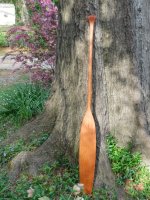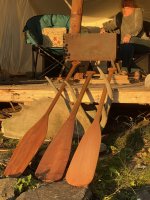I am happy today; I just made my first paddle!
Many years ago I had picked up a copy of “Canoe Paddles A Complete Guide to Making Your Own” by Graham Warren and David Gidmark with the intention of learning how to make a paddle. As it often happens, life got in the way and the book sat on the shelf gathering dust. I would open and read through it occasionally, but the spark of interest never caught fire.
After purchasing my first wood canoe, a Northland, earlier this year I decided that I would like to have a longer bladed lake paddle than is found in my current quiver. I started looking at paddle designs and decided that I would like to try an Ottertail paddle. Since this style is not common in the South-east, I thought of the book and figured that I would give a try at making one. I measured the shaft length on one of my favorite paddles and added the length of the blade design that I chose and got the total length; it would be just over 60” long.
I have a woodworking shop full of tools and wood, so I had a good start. I chose a nice 5/4 (1 ¼” for you non-woodworkers) Cherry board that was in my wood rack. Being that close to my finished shaft diameter, I decided not to plane it down. Fortunately the board was already pretty level and smooth. I used the patterns in the book to make some templates of 1/8” plywood scrap, drew my centerline on the board, traced the templates and bandsawed the rough shape. It started looking like a paddle instead of a piece of lumber. I laid out my side centerlines and side patterns, bandsaw out the neck below the grip, sharpened my Record #4 plane and my Stanly spokeshave and started removing wood. After getting the unwanted wood removed, I started sanding and soon had a paddle that felt nice in my hands and ready for finishing. I put on my first coat of tung oil, wiped it down after 15 minutes and the paddle will dry until tomorrow when I apply my next coat. I will probably give a half dozen coats of so and then use spar varnish on the blade for additional protection. The paddle currently weighs in at 21 ounces and took a little over six hours to make.
I can’t wait to give it a try!
Many years ago I had picked up a copy of “Canoe Paddles A Complete Guide to Making Your Own” by Graham Warren and David Gidmark with the intention of learning how to make a paddle. As it often happens, life got in the way and the book sat on the shelf gathering dust. I would open and read through it occasionally, but the spark of interest never caught fire.
After purchasing my first wood canoe, a Northland, earlier this year I decided that I would like to have a longer bladed lake paddle than is found in my current quiver. I started looking at paddle designs and decided that I would like to try an Ottertail paddle. Since this style is not common in the South-east, I thought of the book and figured that I would give a try at making one. I measured the shaft length on one of my favorite paddles and added the length of the blade design that I chose and got the total length; it would be just over 60” long.
I have a woodworking shop full of tools and wood, so I had a good start. I chose a nice 5/4 (1 ¼” for you non-woodworkers) Cherry board that was in my wood rack. Being that close to my finished shaft diameter, I decided not to plane it down. Fortunately the board was already pretty level and smooth. I used the patterns in the book to make some templates of 1/8” plywood scrap, drew my centerline on the board, traced the templates and bandsawed the rough shape. It started looking like a paddle instead of a piece of lumber. I laid out my side centerlines and side patterns, bandsaw out the neck below the grip, sharpened my Record #4 plane and my Stanly spokeshave and started removing wood. After getting the unwanted wood removed, I started sanding and soon had a paddle that felt nice in my hands and ready for finishing. I put on my first coat of tung oil, wiped it down after 15 minutes and the paddle will dry until tomorrow when I apply my next coat. I will probably give a half dozen coats of so and then use spar varnish on the blade for additional protection. The paddle currently weighs in at 21 ounces and took a little over six hours to make.
I can’t wait to give it a try!


